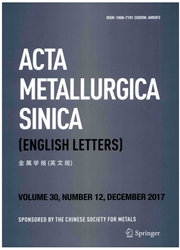

 中文摘要:
中文摘要:
在这份报纸, Ni 公司涂层在超声的焦虑的帮助下是 electrodeposited 到碳钢底层上。涂层被精力分析散 X 光检查分析(EDX ) , X 光检查衍射分析(XRD ) 和扫描电子显微镜学(SEM ) 。粗糙,坚硬和 Ni 公司涂层的腐蚀抵抗上的超声的频率的效果也被调查。结果显示从 20 ~ 120 kHz 的超声的频率的增加减少了 Ni 内容和 Ni 公司涂层的谷物尺寸。而且, electrodeposited 涂层的阶段结构被超声的频率影响。不到 55 kHz 超声的焦虑, Ni 公司涂层是单个 fcc 阶段并且在周围的温度在 5 wt.% NaCl 答案显示出最好的粗糙和最强壮的腐蚀抵抗。在有 90 kHz 的频率的超声的焦虑下面,涂层是 fcc 和 hcp 结构的混合物并且显示出大约 420 HV 的最大的坚硬。因此,超声的焦虑帮助了减少粗糙,并且提高坚硬和 Ni 公司涂层的腐蚀抵抗。
 英文摘要:
英文摘要:
In this paper, Ni-Co coatings were electrodeposited onto carbon steel substrates with the aid of ultrasonic agitation. The coatings were analyzed by energy dispersive X-ray analysis (EDX), X-ray diffraction analysis (XRD) and scanning electron microscopy (SEM). The effects of the ultrasonic frequency on the roughness, hardness and corrosion resistance of the Ni-Co coatings were also investigated. The results indicated that the increase of the ultrasonic frequency from 20 to 120 kHz reduced the Ni content and the grain size of Ni-Co coatings. Moreover, the phase structure of the electrodeposited coatings was influenced by the ultrasonic frequency. Under 55 kHz ultrasonic agitation, the Ni-Co coating was single fcc phase and showed the finest roughness and the strongest corrosion resistance in 5 wt.% NaCl solution at the ambient temperature. Under ultrasonic agitation with frequency of 90 kHz, the coating was a mixture of fcc and hcp structure and showed the maximal hardness of about 420 HV. Therefore, ultrasonic agitation helped decrease the roughness, and enhance hardness and corrosion resistance of Ni-Co coatings.
 同期刊论文项目
同期刊论文项目
 同项目期刊论文
同项目期刊论文
 The influence of ultrasonic frequency on the properties of Ni-Co coatings prepared by ultrasound-ass
The influence of ultrasonic frequency on the properties of Ni-Co coatings prepared by ultrasound-ass 期刊信息
期刊信息
